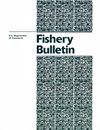切萨皮克湾河流中alewife(Alosa pseudoharengus)和蓝背鲱(A.aestivalis)产卵迁徙的时间和环境驱动因素
IF 0.8
4区 农林科学
Q3 FISHERIES
引用次数: 0
摘要
--每年的生活史事件,如鱼类的迁徙和产卵,通常与环境条件的季节性波动相匹配。为了保护脆弱的鱼类种群,特别是在气候变化扰乱季节性转变的情况下,需要了解酚类模式及其驱动因素。在这项研究中,我们研究了7年来(2013-2019年),在切萨皮克湾的4条河流中,河鲱、alewife(Alosa pseudoharengus)和蓝背鲱(A.aestiva lis)春季产卵迁徙的表型。我们使用成像声纳和每周生物样本来估计Choptank河、Deer Creek(Susquehanna河的一条支流)、Marhyhope Creek(Nanticoke河的一个支流)和Patapsco河中每小时特定物种的鱼类数量。我们的研究结果表明,春季的水温模式在季节、每日和每小时的尺度上推动产卵迁移。鱼类数量与其他环境因素(如水流、月相、浊度、风应力和潮汐)之间的关系每年都不一致,它们对迁徙的影响可能是特定于河流的。对于这两个物种,观察到了不同的昼夜运动模式。乔普坦克河和马希霍普河的迁徙是白天进行的,而鹿溪和帕塔普斯科河的迁徙则是夜间进行的。观察到的年际和河流间的酚学变化以及非温度因素对迁徙的影响,突出了对切萨皮克湾河流鲱鱼进行长期、多河流监测的必要性。本文章由计算机程序翻译,如有差异,请以英文原文为准。
Timing and environmental drivers of spawning migrations of alewife (Alosa pseudoharengus) and blueback herring (A. aestivalis) in rivers of Chesapeake Bay
— Annual life history events, such as migration and spawning in fish, are often timed to match seasonal fluctuations in environmental conditions. Understanding phenological patterns and their drivers is needed to conserve vulnerable fish populations, particularly as climate change is disrupting seasonal transitions. In this study, we examined the phenology of spring spawning migrations of river herring, the alewife ( Alosa pseudoharengus ) and the blueback herring ( A. aestiva-lis ), in 4 rivers of Chesapeake Bay over 7 years (2013–2019). We used imaging sonar and weekly biological samples to estimate species-specific hourly fish counts in the Choptank River, Deer Creek (a tributary of Susquehanna River), Marshyhope Creek (a tributary of Nanticoke River), and the Patapsco River. Our results indicate that patterns of water temperature in spring drive spawning migrations at seasonal, daily, and hourly scales. The relationship between fish counts and other environmental factors, such as stream-flow, lunar phase, turbidity, wind stress, and tides, were annually inconsistent, and their influences on migrations may be river specific. For both species, distinct diel patterns in movement were observed. Migrations were diurnal in the Choptank River and Marshyhope Creek but nocturnal in Deer Creek and the Patapsco River. Observed interannual and inter-river variation in phenology and the influence of non-temperature factors on migrations highlight the need for long-term, multi-river monitoring of river herring in Chesapeake Bay.
求助全文
通过发布文献求助,成功后即可免费获取论文全文。
去求助
来源期刊

Fishery Bulletin
农林科学-渔业
CiteScore
1.70
自引率
12.50%
发文量
76
审稿时长
>24 weeks
期刊介绍:
The quarterly Fishery Bulletin is one of the oldest and most respected fisheries journals in the world. It has been an official publication of the U.S. Government since 1881, under various titles, and is the U.S. counterpart to other highly regarded governmental fisheries science publications. It publishes original research and interpretative articles in all scientific fields that bear on marine fisheries and marine mammal science.
 求助内容:
求助内容: 应助结果提醒方式:
应助结果提醒方式:


